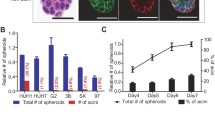Abstract
3D Cell culture is an alternative to animal use in many drug development and toxicity studies. The 3D cell culture can mimic and reproduce the original tissue microenvironment, morphology, and mechanical and physiological characteristics, to provide a more realistic and reliable response as compared to two-dimensional cultures. 3D cell culture encapsulated in alginate beads is a very simple and relatively inexpensive tool that is easy to handle and to maintain. The alginate beads function as a scaffold that imprisons cells and allows 3D cell growth, to generate spheroids that can have greater genic expression and cell–cell communication as a nano or microtissue. The HepG2 cell line is a human hepatocellular carcinoma cell derivative. HepG2 cells preserve several of the characteristics of hepatocytes and are therefore often used in toxicity studies. Here, we describe HepG2 cell encapsulation in alginate beads and analyze the resulting spheroids formed within the alginate beads by immunocytochemistry, by staining a certain structure with a specific antibody coupled with a fluorophore. This method preserves the beads and enables cell analysis by confocal microscopy.
Access this chapter
Tax calculation will be finalised at checkout
Purchases are for personal use only
Similar content being viewed by others
References
Chitrangi SN, P and Khanna, A. (2017) 3D engineered in vitro hepatospheroids for study drug toxicity and metabolism. Toxicol In Vitro 38:8–18
Russel WMS, Burch RL (1953). The principle of human experimental technique. http://altweb.jhsph.edu/pubs/books/humane_exp/het-toc>. Accessed Sept 27 2017
Lee J et al (2008) Three-dimensional cell culture matrices: state of art. Tissue Eng Part B Rev 14(1):61–86
Pampaloni F, Stelzer EHK (2009) Three-dimensional cell cultures in toxicology. Biotechnol Genet Eng Rev 26:129–150
Lan SF, Mroczka BS, Starly B (2010) Long-term cultivation of HepG2 liver cells encapsulated in alginate hydrogels: a study of cell viability. Morphology and drug metabolism. Toxicol In Vitro 24:1314–1323
Mazzoleni G, Di Lorenzo D, Steimberg N (2009) Modelling tissues in 3D: the next future of pharmaco-toxicology and food research? Genes Nutr 4:13–22
Kim JY et al (2015) 3D spherical microtissues and microfluidic technology for multi-tissue experiments and analysis. J Biotechnol 205:24–35
Andrei G (2006) Three-dimensional culture models for human viral diseases and antiviral drug development. Mini-review. Antivir Res 71:96–107
Huang X, Zhang X, Wang X, Wang C, Tang B (2012) Microenvironment of alginate-based microcapsules for cell culture and tissue engineering, review. J Biosci Bioeng 114:1–8
Andersen T, Auk-Emblem P, Dornish M (2015) 3D cell culture in alginate hydrogels, review. Microarrays 4:133–161
Drury JL, Mooney DJ (2003) Hydrogels for tissue engineering: scaffold design variables and applications. Review. Biomaterials 24:4337–4351
Burry RW (2011) Controls for immunocytochemistry: an update. J Histochem Cytochem 59(1):6–12
Author information
Authors and Affiliations
Corresponding author
Editor information
Editors and Affiliations
Rights and permissions
Copyright information
© 2021 Springer Science+Business Media, LLC, part of Springer Nature
About this protocol
Cite this protocol
Miranda, R.G., Ferraz, E.R.A., Pereira, L.C., Dorta, D.J. (2021). Immunocytochemistry Analysis of HepG2 Cell 3D Culture Encapsulated as Spheroids in Alginate Beads. In: Palmeira, C.M.M., de Oliveira, D.P., Dorta, D.J. (eds) Toxicity Assessment. Methods in Molecular Biology, vol 2240. Humana, New York, NY. https://doi.org/10.1007/978-1-0716-1091-6_14
Download citation
DOI: https://doi.org/10.1007/978-1-0716-1091-6_14
Published:
Publisher Name: Humana, New York, NY
Print ISBN: 978-1-0716-1090-9
Online ISBN: 978-1-0716-1091-6
eBook Packages: Springer Protocols




